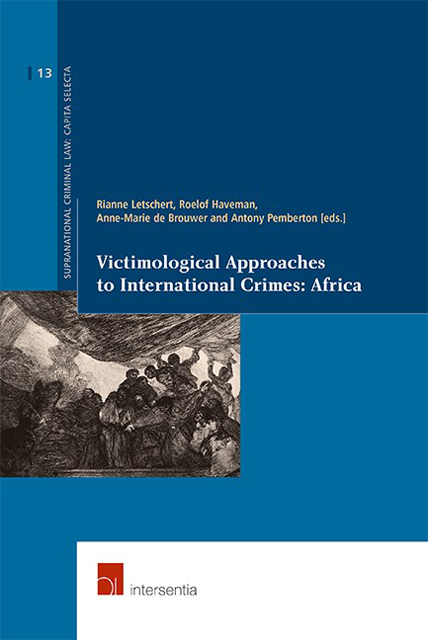Book contents
- Frontmatter
- Words of Appreciation
- Contents
- Introduction: Victimological Approaches to International Crimes
- Part I Victims of International Crimes
- Part II Reparative Justice
- PART III Amnesty, Truth, Reconciliation and Tradition
- Part IV International and National Legal and Policy Approaches
- Part V Victimological Approaches to International Crimes
- The Authors
- Bibliography
XII - The South African Truth and Reconciliation Commission: Challenges in Contributing to Reconciliation
Published online by Cambridge University Press: 24 November 2022
- Frontmatter
- Words of Appreciation
- Contents
- Introduction: Victimological Approaches to International Crimes
- Part I Victims of International Crimes
- Part II Reparative Justice
- PART III Amnesty, Truth, Reconciliation and Tradition
- Part IV International and National Legal and Policy Approaches
- Part V Victimological Approaches to International Crimes
- The Authors
- Bibliography
Summary
INTRODUCTION
South Africa is a country that emerged from the most inhumane racial oppression orchestrated by the apartheid regime. Apartheid sought to dehumanise South Africans and the Truth and Reconciliation Commission (TRC) forced a country to redefine itself through the accounts of its victims and perpetrators, or as Krog (2002, 293) asserted “we have to become each other, or for ever lose the spine of being”. The TRC is the most visible vehicle that made this redefinition possible but for a new democratic and reconciled order whose future relies on emerging and transcending an atrocious past, reconciliation had to become part of a much broader process. The following discussion will focus on various challenges associated with reconciliation, but for purposes of contextualising the challenges of a transitional society, it is first necessary to briefly discuss the institution of apartheid as well as key elements pertaining to the nature and functioning of the TRC.
BRIEF OVERVIEW OF APARTHEID
In South Africa the roots of apartheid can be traced back to its colonial era. In 1652, Jan van Riebeeck from the Dutch East India Trading Company founded a permanent settlement in the Cape of Good Hope. In 1795 the Cape colony was seized by the British, recovered by the Dutch and seized again by the British in 1806. Since its first colonisation and regardless of its colonial powers, and with the aid of slavery, a long history was established of white dominance over Africans in this region (Elian 2003; Loomba 2005). Despite such prolonged period of white dominance, the term apartheid (from the Afrikaans word ‘apartness’) only emerged as a political slogan of the National Party in the early 1940s (Oomen 2005). Subsequently, when the Afrikaner Nationalists came into power in 1948, the white supremacist policy of racial domination and segregation was further institutionalised through a plethora of laws:
– The Population Registration Act (Act No 30 of 1950) that formalised racial classification can be referred to as the first ‘grand’ apartheid law that classified all South Africans into one of four racial categories: Bantu (black African), white, ‘Coloured’ (of mixed race) and Asian (Indians and Pakistanis). This classification led to the creation of a national register in which every person's race was recorded.
- Type
- Chapter
- Information
- Victimological Approaches to International Crimes: Africa , pp. 315 - 334Publisher: IntersentiaPrint publication year: 2011
- 2
- Cited by

